A Case Study: Analyzing Factors Shaping Higher Education Policy
VerifiedAdded on 2023/06/04
|11
|3433
|88
Case Study
AI Summary
This case study delves into the social, economic, and political factors that impact the implementation and development of Australian higher education policy. It begins by highlighting the government's efforts to bridge the gap between less fortunate and wealthy students, emphasizing the importance of equality and opportunity. The analysis then focuses on fee policy deregulation, aiming to fund more students and promote equality. The study also addresses issues such as the scrutiny of policy beneficiaries and the challenge of loan defaults. Social factors like inadequate public information and ignorance, economic factors like increasing government expenditure and public debt, and political factors like senate hesitations and budget limitations are all explored. The study further discusses the importance of labor market perspectives and the government's role in skills development and vocational training, while also acknowledging the challenges posed by brain drain and the need for policy clarity and funding.
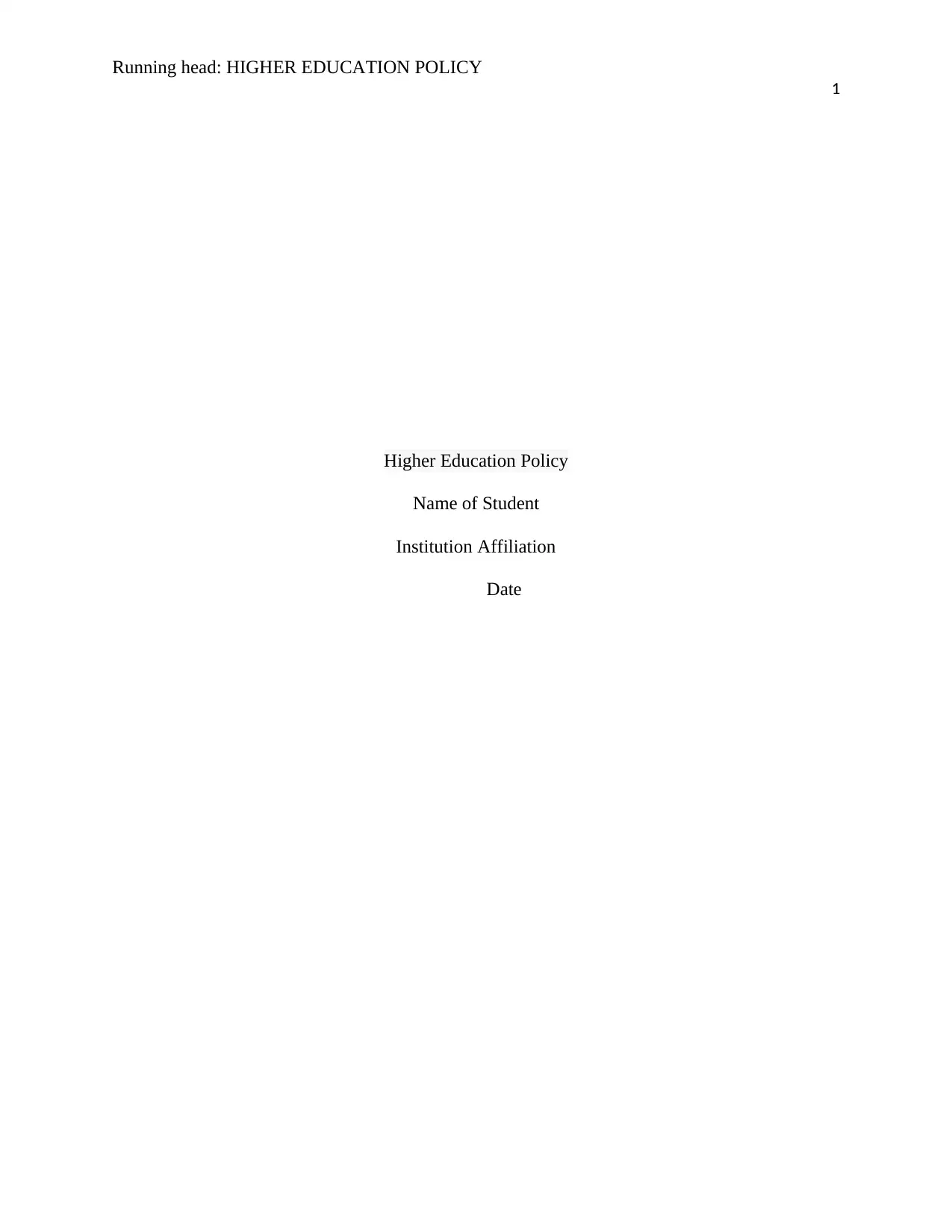
Running head: HIGHER EDUCATION POLICY
1
Higher Education Policy
Name of Student
Institution Affiliation
Date
1
Higher Education Policy
Name of Student
Institution Affiliation
Date
Paraphrase This Document
Need a fresh take? Get an instant paraphrase of this document with our AI Paraphraser
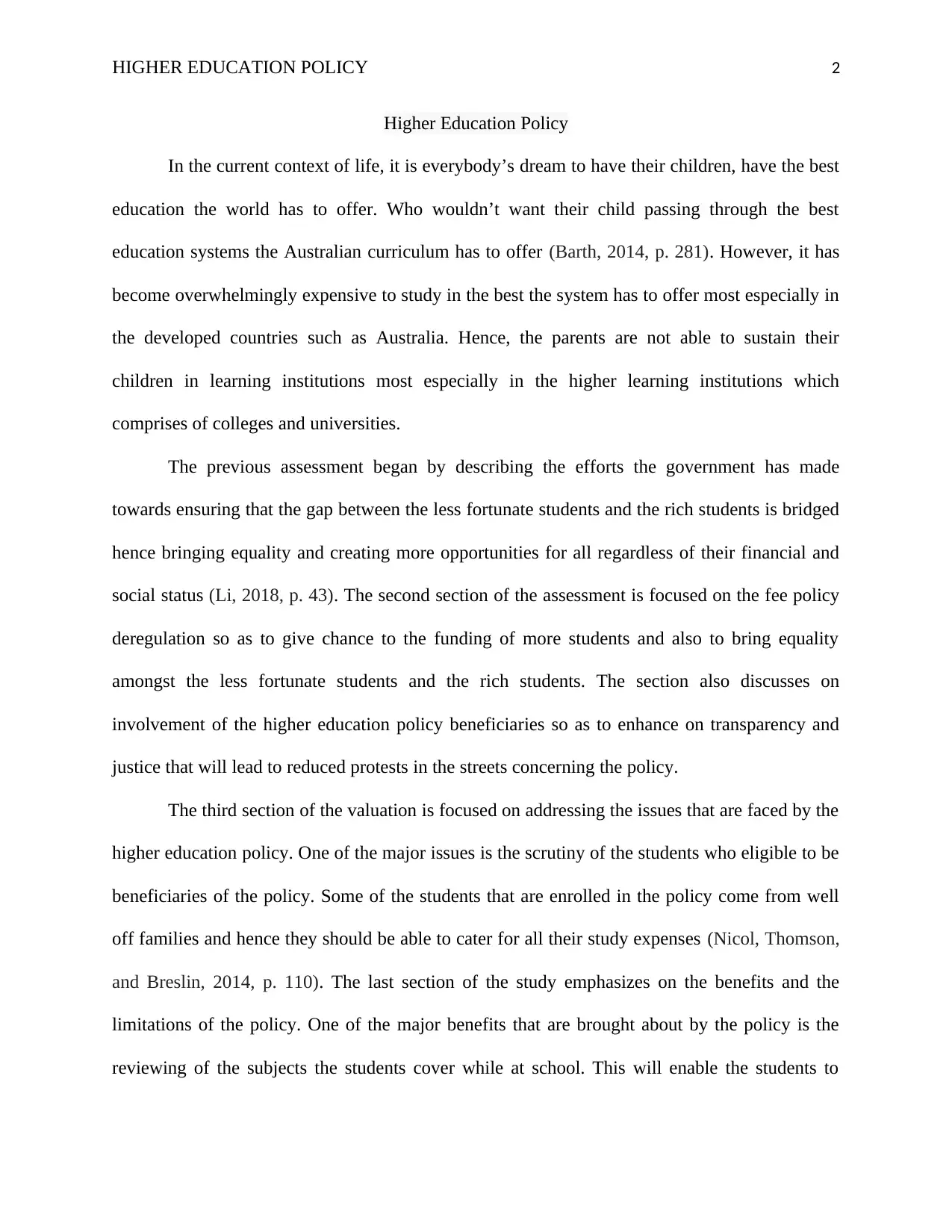
HIGHER EDUCATION POLICY 2
Higher Education Policy
In the current context of life, it is everybody’s dream to have their children, have the best
education the world has to offer. Who wouldn’t want their child passing through the best
education systems the Australian curriculum has to offer (Barth, 2014, p. 281). However, it has
become overwhelmingly expensive to study in the best the system has to offer most especially in
the developed countries such as Australia. Hence, the parents are not able to sustain their
children in learning institutions most especially in the higher learning institutions which
comprises of colleges and universities.
The previous assessment began by describing the efforts the government has made
towards ensuring that the gap between the less fortunate students and the rich students is bridged
hence bringing equality and creating more opportunities for all regardless of their financial and
social status (Li, 2018, p. 43). The second section of the assessment is focused on the fee policy
deregulation so as to give chance to the funding of more students and also to bring equality
amongst the less fortunate students and the rich students. The section also discusses on
involvement of the higher education policy beneficiaries so as to enhance on transparency and
justice that will lead to reduced protests in the streets concerning the policy.
The third section of the valuation is focused on addressing the issues that are faced by the
higher education policy. One of the major issues is the scrutiny of the students who eligible to be
beneficiaries of the policy. Some of the students that are enrolled in the policy come from well
off families and hence they should be able to cater for all their study expenses (Nicol, Thomson,
and Breslin, 2014, p. 110). The last section of the study emphasizes on the benefits and the
limitations of the policy. One of the major benefits that are brought about by the policy is the
reviewing of the subjects the students cover while at school. This will enable the students to
Higher Education Policy
In the current context of life, it is everybody’s dream to have their children, have the best
education the world has to offer. Who wouldn’t want their child passing through the best
education systems the Australian curriculum has to offer (Barth, 2014, p. 281). However, it has
become overwhelmingly expensive to study in the best the system has to offer most especially in
the developed countries such as Australia. Hence, the parents are not able to sustain their
children in learning institutions most especially in the higher learning institutions which
comprises of colleges and universities.
The previous assessment began by describing the efforts the government has made
towards ensuring that the gap between the less fortunate students and the rich students is bridged
hence bringing equality and creating more opportunities for all regardless of their financial and
social status (Li, 2018, p. 43). The second section of the assessment is focused on the fee policy
deregulation so as to give chance to the funding of more students and also to bring equality
amongst the less fortunate students and the rich students. The section also discusses on
involvement of the higher education policy beneficiaries so as to enhance on transparency and
justice that will lead to reduced protests in the streets concerning the policy.
The third section of the valuation is focused on addressing the issues that are faced by the
higher education policy. One of the major issues is the scrutiny of the students who eligible to be
beneficiaries of the policy. Some of the students that are enrolled in the policy come from well
off families and hence they should be able to cater for all their study expenses (Nicol, Thomson,
and Breslin, 2014, p. 110). The last section of the study emphasizes on the benefits and the
limitations of the policy. One of the major benefits that are brought about by the policy is the
reviewing of the subjects the students cover while at school. This will enable the students to
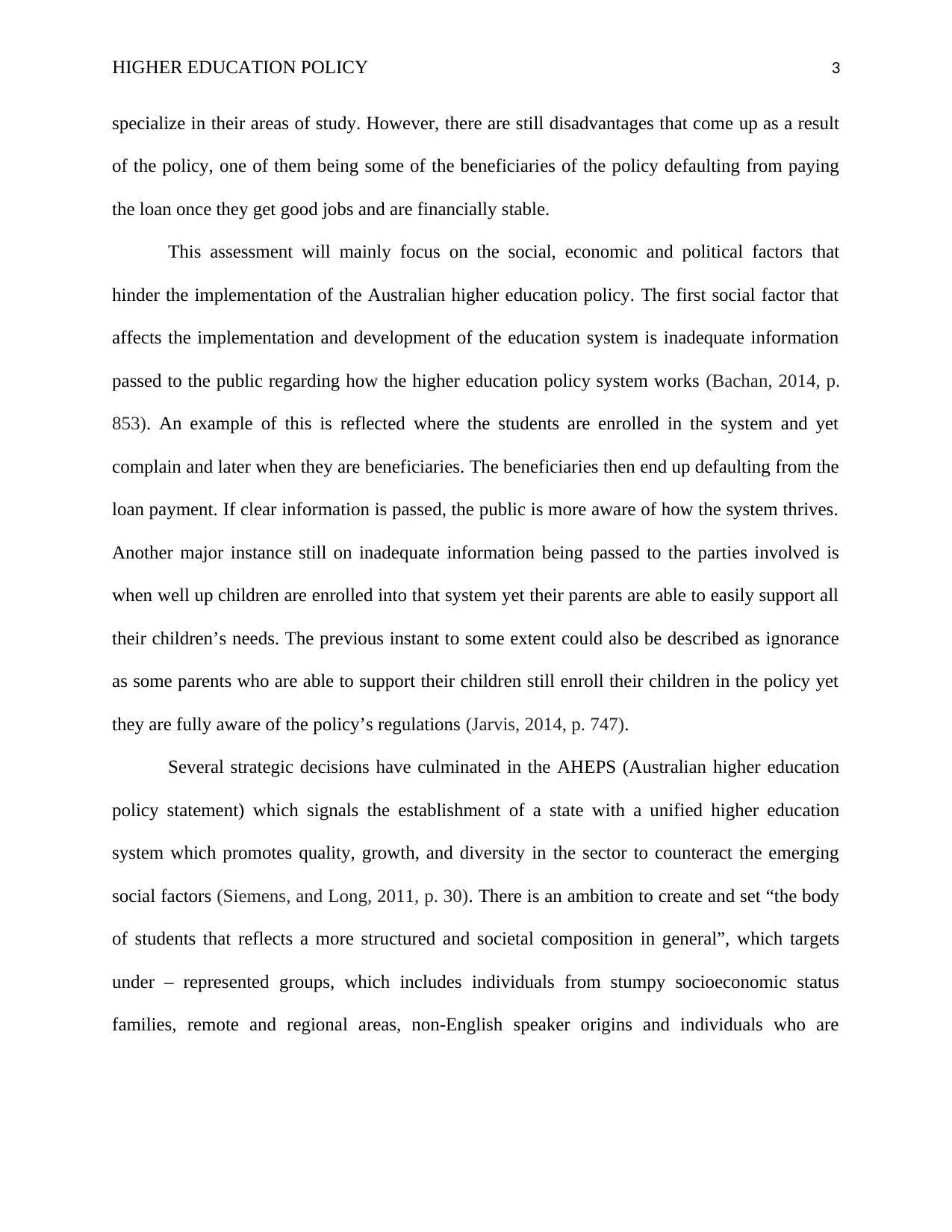
HIGHER EDUCATION POLICY 3
specialize in their areas of study. However, there are still disadvantages that come up as a result
of the policy, one of them being some of the beneficiaries of the policy defaulting from paying
the loan once they get good jobs and are financially stable.
This assessment will mainly focus on the social, economic and political factors that
hinder the implementation of the Australian higher education policy. The first social factor that
affects the implementation and development of the education system is inadequate information
passed to the public regarding how the higher education policy system works (Bachan, 2014, p.
853). An example of this is reflected where the students are enrolled in the system and yet
complain and later when they are beneficiaries. The beneficiaries then end up defaulting from the
loan payment. If clear information is passed, the public is more aware of how the system thrives.
Another major instance still on inadequate information being passed to the parties involved is
when well up children are enrolled into that system yet their parents are able to easily support all
their children’s needs. The previous instant to some extent could also be described as ignorance
as some parents who are able to support their children still enroll their children in the policy yet
they are fully aware of the policy’s regulations (Jarvis, 2014, p. 747).
Several strategic decisions have culminated in the AHEPS (Australian higher education
policy statement) which signals the establishment of a state with a unified higher education
system which promotes quality, growth, and diversity in the sector to counteract the emerging
social factors (Siemens, and Long, 2011, p. 30). There is an ambition to create and set “the body
of students that reflects a more structured and societal composition in general”, which targets
under – represented groups, which includes individuals from stumpy socioeconomic status
families, remote and regional areas, non-English speaker origins and individuals who are
specialize in their areas of study. However, there are still disadvantages that come up as a result
of the policy, one of them being some of the beneficiaries of the policy defaulting from paying
the loan once they get good jobs and are financially stable.
This assessment will mainly focus on the social, economic and political factors that
hinder the implementation of the Australian higher education policy. The first social factor that
affects the implementation and development of the education system is inadequate information
passed to the public regarding how the higher education policy system works (Bachan, 2014, p.
853). An example of this is reflected where the students are enrolled in the system and yet
complain and later when they are beneficiaries. The beneficiaries then end up defaulting from the
loan payment. If clear information is passed, the public is more aware of how the system thrives.
Another major instance still on inadequate information being passed to the parties involved is
when well up children are enrolled into that system yet their parents are able to easily support all
their children’s needs. The previous instant to some extent could also be described as ignorance
as some parents who are able to support their children still enroll their children in the policy yet
they are fully aware of the policy’s regulations (Jarvis, 2014, p. 747).
Several strategic decisions have culminated in the AHEPS (Australian higher education
policy statement) which signals the establishment of a state with a unified higher education
system which promotes quality, growth, and diversity in the sector to counteract the emerging
social factors (Siemens, and Long, 2011, p. 30). There is an ambition to create and set “the body
of students that reflects a more structured and societal composition in general”, which targets
under – represented groups, which includes individuals from stumpy socioeconomic status
families, remote and regional areas, non-English speaker origins and individuals who are
⊘ This is a preview!⊘
Do you want full access?
Subscribe today to unlock all pages.

Trusted by 1+ million students worldwide
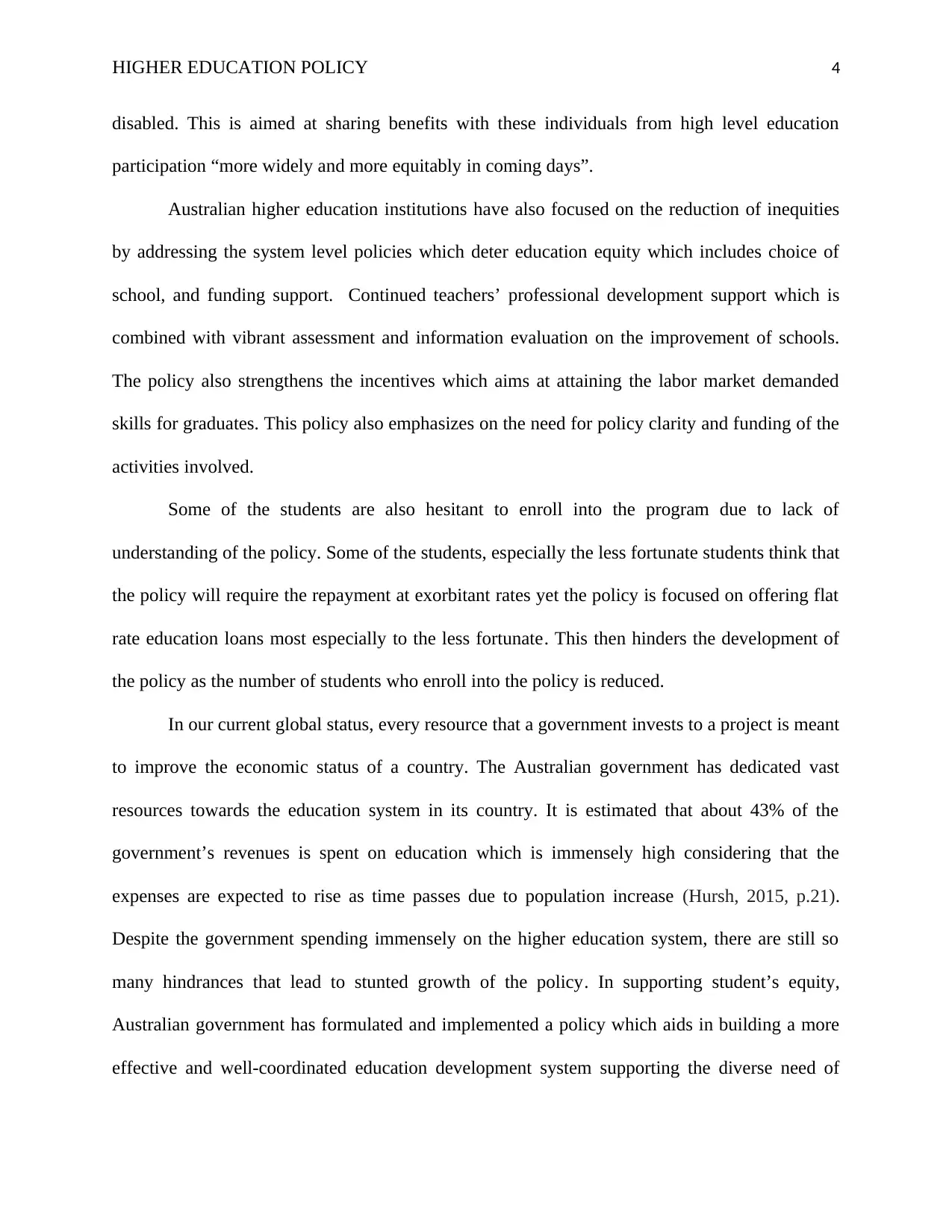
HIGHER EDUCATION POLICY 4
disabled. This is aimed at sharing benefits with these individuals from high level education
participation “more widely and more equitably in coming days”.
Australian higher education institutions have also focused on the reduction of inequities
by addressing the system level policies which deter education equity which includes choice of
school, and funding support. Continued teachers’ professional development support which is
combined with vibrant assessment and information evaluation on the improvement of schools.
The policy also strengthens the incentives which aims at attaining the labor market demanded
skills for graduates. This policy also emphasizes on the need for policy clarity and funding of the
activities involved.
Some of the students are also hesitant to enroll into the program due to lack of
understanding of the policy. Some of the students, especially the less fortunate students think that
the policy will require the repayment at exorbitant rates yet the policy is focused on offering flat
rate education loans most especially to the less fortunate. This then hinders the development of
the policy as the number of students who enroll into the policy is reduced.
In our current global status, every resource that a government invests to a project is meant
to improve the economic status of a country. The Australian government has dedicated vast
resources towards the education system in its country. It is estimated that about 43% of the
government’s revenues is spent on education which is immensely high considering that the
expenses are expected to rise as time passes due to population increase (Hursh, 2015, p.21).
Despite the government spending immensely on the higher education system, there are still so
many hindrances that lead to stunted growth of the policy. In supporting student’s equity,
Australian government has formulated and implemented a policy which aids in building a more
effective and well-coordinated education development system supporting the diverse need of
disabled. This is aimed at sharing benefits with these individuals from high level education
participation “more widely and more equitably in coming days”.
Australian higher education institutions have also focused on the reduction of inequities
by addressing the system level policies which deter education equity which includes choice of
school, and funding support. Continued teachers’ professional development support which is
combined with vibrant assessment and information evaluation on the improvement of schools.
The policy also strengthens the incentives which aims at attaining the labor market demanded
skills for graduates. This policy also emphasizes on the need for policy clarity and funding of the
activities involved.
Some of the students are also hesitant to enroll into the program due to lack of
understanding of the policy. Some of the students, especially the less fortunate students think that
the policy will require the repayment at exorbitant rates yet the policy is focused on offering flat
rate education loans most especially to the less fortunate. This then hinders the development of
the policy as the number of students who enroll into the policy is reduced.
In our current global status, every resource that a government invests to a project is meant
to improve the economic status of a country. The Australian government has dedicated vast
resources towards the education system in its country. It is estimated that about 43% of the
government’s revenues is spent on education which is immensely high considering that the
expenses are expected to rise as time passes due to population increase (Hursh, 2015, p.21).
Despite the government spending immensely on the higher education system, there are still so
many hindrances that lead to stunted growth of the policy. In supporting student’s equity,
Australian government has formulated and implemented a policy which aids in building a more
effective and well-coordinated education development system supporting the diverse need of
Paraphrase This Document
Need a fresh take? Get an instant paraphrase of this document with our AI Paraphraser
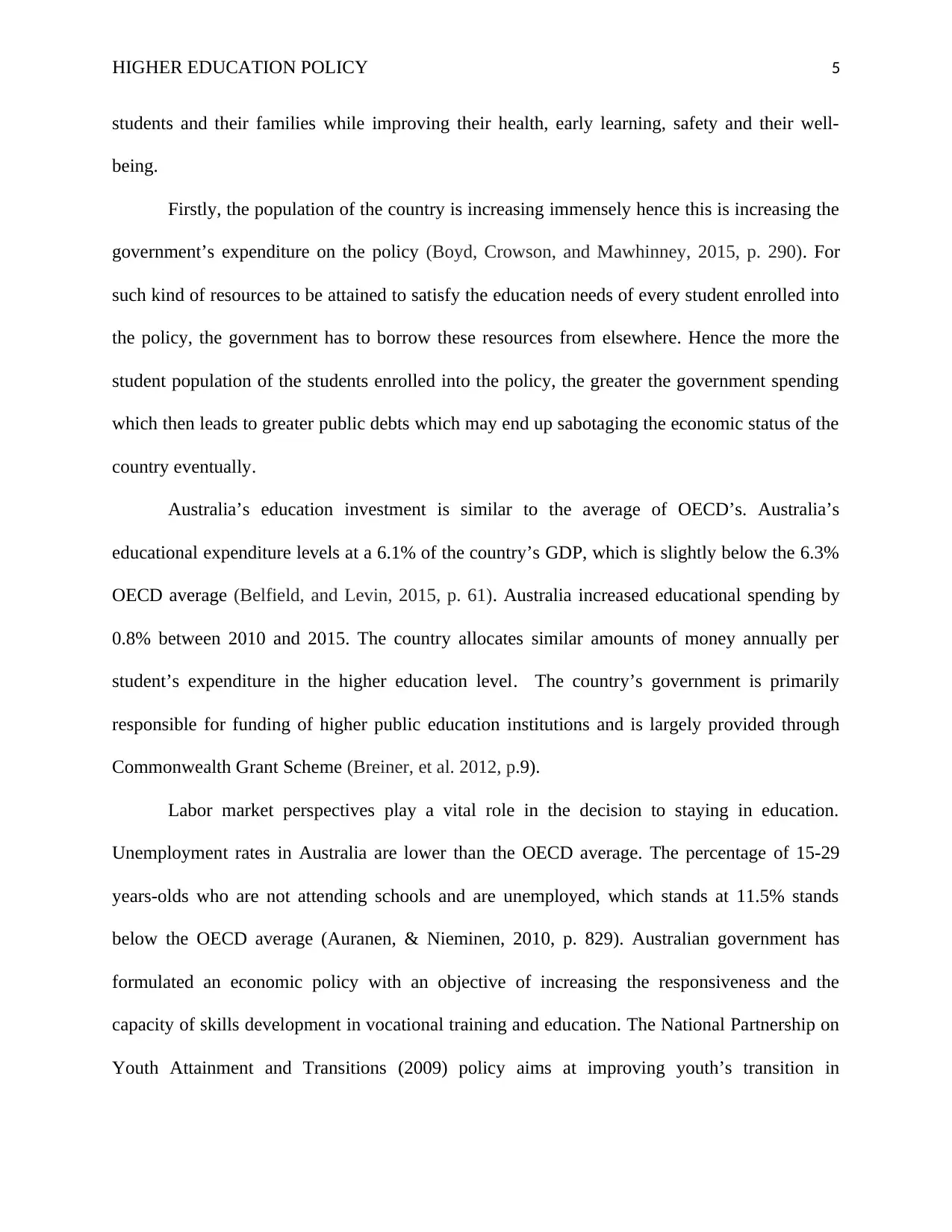
HIGHER EDUCATION POLICY 5
students and their families while improving their health, early learning, safety and their well-
being.
Firstly, the population of the country is increasing immensely hence this is increasing the
government’s expenditure on the policy (Boyd, Crowson, and Mawhinney, 2015, p. 290). For
such kind of resources to be attained to satisfy the education needs of every student enrolled into
the policy, the government has to borrow these resources from elsewhere. Hence the more the
student population of the students enrolled into the policy, the greater the government spending
which then leads to greater public debts which may end up sabotaging the economic status of the
country eventually.
Australia’s education investment is similar to the average of OECD’s. Australia’s
educational expenditure levels at a 6.1% of the country’s GDP, which is slightly below the 6.3%
OECD average (Belfield, and Levin, 2015, p. 61). Australia increased educational spending by
0.8% between 2010 and 2015. The country allocates similar amounts of money annually per
student’s expenditure in the higher education level. The country’s government is primarily
responsible for funding of higher public education institutions and is largely provided through
Commonwealth Grant Scheme (Breiner, et al. 2012, p.9).
Labor market perspectives play a vital role in the decision to staying in education.
Unemployment rates in Australia are lower than the OECD average. The percentage of 15-29
years-olds who are not attending schools and are unemployed, which stands at 11.5% stands
below the OECD average (Auranen, & Nieminen, 2010, p. 829). Australian government has
formulated an economic policy with an objective of increasing the responsiveness and the
capacity of skills development in vocational training and education. The National Partnership on
Youth Attainment and Transitions (2009) policy aims at improving youth’s transition in
students and their families while improving their health, early learning, safety and their well-
being.
Firstly, the population of the country is increasing immensely hence this is increasing the
government’s expenditure on the policy (Boyd, Crowson, and Mawhinney, 2015, p. 290). For
such kind of resources to be attained to satisfy the education needs of every student enrolled into
the policy, the government has to borrow these resources from elsewhere. Hence the more the
student population of the students enrolled into the policy, the greater the government spending
which then leads to greater public debts which may end up sabotaging the economic status of the
country eventually.
Australia’s education investment is similar to the average of OECD’s. Australia’s
educational expenditure levels at a 6.1% of the country’s GDP, which is slightly below the 6.3%
OECD average (Belfield, and Levin, 2015, p. 61). Australia increased educational spending by
0.8% between 2010 and 2015. The country allocates similar amounts of money annually per
student’s expenditure in the higher education level. The country’s government is primarily
responsible for funding of higher public education institutions and is largely provided through
Commonwealth Grant Scheme (Breiner, et al. 2012, p.9).
Labor market perspectives play a vital role in the decision to staying in education.
Unemployment rates in Australia are lower than the OECD average. The percentage of 15-29
years-olds who are not attending schools and are unemployed, which stands at 11.5% stands
below the OECD average (Auranen, & Nieminen, 2010, p. 829). Australian government has
formulated an economic policy with an objective of increasing the responsiveness and the
capacity of skills development in vocational training and education. The National Partnership on
Youth Attainment and Transitions (2009) policy aims at improving youth’s transition in
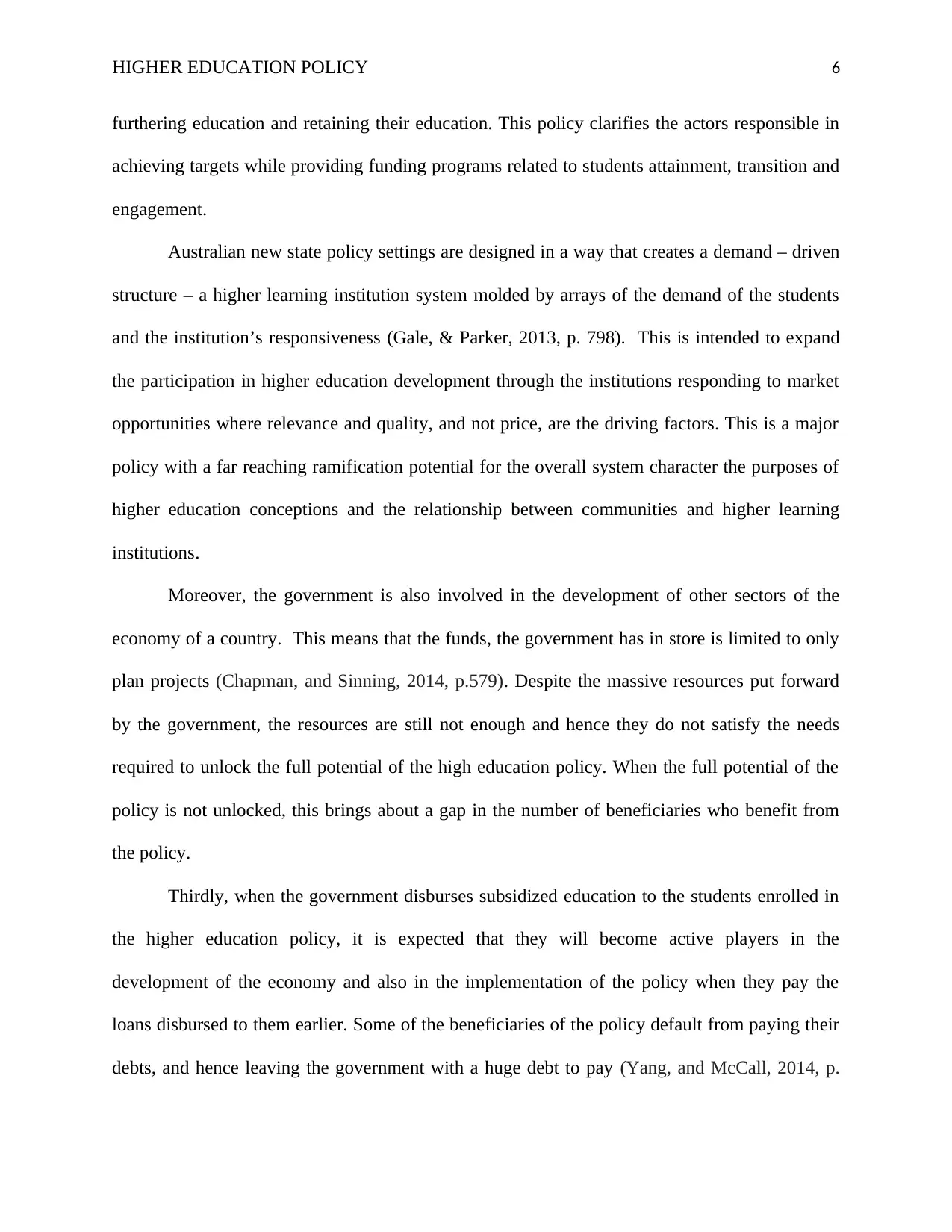
HIGHER EDUCATION POLICY 6
furthering education and retaining their education. This policy clarifies the actors responsible in
achieving targets while providing funding programs related to students attainment, transition and
engagement.
Australian new state policy settings are designed in a way that creates a demand – driven
structure – a higher learning institution system molded by arrays of the demand of the students
and the institution’s responsiveness (Gale, & Parker, 2013, p. 798). This is intended to expand
the participation in higher education development through the institutions responding to market
opportunities where relevance and quality, and not price, are the driving factors. This is a major
policy with a far reaching ramification potential for the overall system character the purposes of
higher education conceptions and the relationship between communities and higher learning
institutions.
Moreover, the government is also involved in the development of other sectors of the
economy of a country. This means that the funds, the government has in store is limited to only
plan projects (Chapman, and Sinning, 2014, p.579). Despite the massive resources put forward
by the government, the resources are still not enough and hence they do not satisfy the needs
required to unlock the full potential of the high education policy. When the full potential of the
policy is not unlocked, this brings about a gap in the number of beneficiaries who benefit from
the policy.
Thirdly, when the government disburses subsidized education to the students enrolled in
the higher education policy, it is expected that they will become active players in the
development of the economy and also in the implementation of the policy when they pay the
loans disbursed to them earlier. Some of the beneficiaries of the policy default from paying their
debts, and hence leaving the government with a huge debt to pay (Yang, and McCall, 2014, p.
furthering education and retaining their education. This policy clarifies the actors responsible in
achieving targets while providing funding programs related to students attainment, transition and
engagement.
Australian new state policy settings are designed in a way that creates a demand – driven
structure – a higher learning institution system molded by arrays of the demand of the students
and the institution’s responsiveness (Gale, & Parker, 2013, p. 798). This is intended to expand
the participation in higher education development through the institutions responding to market
opportunities where relevance and quality, and not price, are the driving factors. This is a major
policy with a far reaching ramification potential for the overall system character the purposes of
higher education conceptions and the relationship between communities and higher learning
institutions.
Moreover, the government is also involved in the development of other sectors of the
economy of a country. This means that the funds, the government has in store is limited to only
plan projects (Chapman, and Sinning, 2014, p.579). Despite the massive resources put forward
by the government, the resources are still not enough and hence they do not satisfy the needs
required to unlock the full potential of the high education policy. When the full potential of the
policy is not unlocked, this brings about a gap in the number of beneficiaries who benefit from
the policy.
Thirdly, when the government disburses subsidized education to the students enrolled in
the higher education policy, it is expected that they will become active players in the
development of the economy and also in the implementation of the policy when they pay the
loans disbursed to them earlier. Some of the beneficiaries of the policy default from paying their
debts, and hence leaving the government with a huge debt to pay (Yang, and McCall, 2014, p.
⊘ This is a preview!⊘
Do you want full access?
Subscribe today to unlock all pages.

Trusted by 1+ million students worldwide
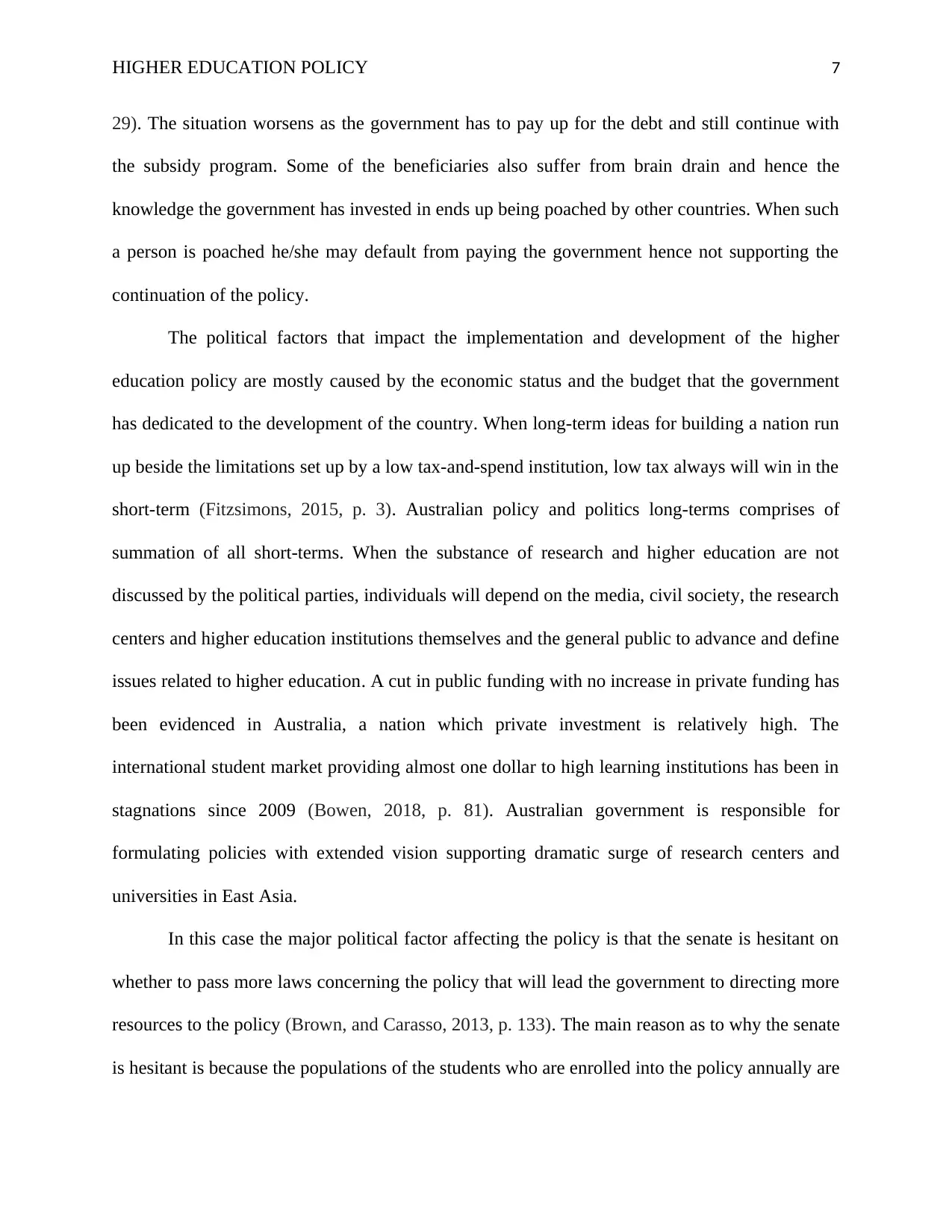
HIGHER EDUCATION POLICY 7
29). The situation worsens as the government has to pay up for the debt and still continue with
the subsidy program. Some of the beneficiaries also suffer from brain drain and hence the
knowledge the government has invested in ends up being poached by other countries. When such
a person is poached he/she may default from paying the government hence not supporting the
continuation of the policy.
The political factors that impact the implementation and development of the higher
education policy are mostly caused by the economic status and the budget that the government
has dedicated to the development of the country. When long-term ideas for building a nation run
up beside the limitations set up by a low tax-and-spend institution, low tax always will win in the
short-term (Fitzsimons, 2015, p. 3). Australian policy and politics long-terms comprises of
summation of all short-terms. When the substance of research and higher education are not
discussed by the political parties, individuals will depend on the media, civil society, the research
centers and higher education institutions themselves and the general public to advance and define
issues related to higher education. A cut in public funding with no increase in private funding has
been evidenced in Australia, a nation which private investment is relatively high. The
international student market providing almost one dollar to high learning institutions has been in
stagnations since 2009 (Bowen, 2018, p. 81). Australian government is responsible for
formulating policies with extended vision supporting dramatic surge of research centers and
universities in East Asia.
In this case the major political factor affecting the policy is that the senate is hesitant on
whether to pass more laws concerning the policy that will lead the government to directing more
resources to the policy (Brown, and Carasso, 2013, p. 133). The main reason as to why the senate
is hesitant is because the populations of the students who are enrolled into the policy annually are
29). The situation worsens as the government has to pay up for the debt and still continue with
the subsidy program. Some of the beneficiaries also suffer from brain drain and hence the
knowledge the government has invested in ends up being poached by other countries. When such
a person is poached he/she may default from paying the government hence not supporting the
continuation of the policy.
The political factors that impact the implementation and development of the higher
education policy are mostly caused by the economic status and the budget that the government
has dedicated to the development of the country. When long-term ideas for building a nation run
up beside the limitations set up by a low tax-and-spend institution, low tax always will win in the
short-term (Fitzsimons, 2015, p. 3). Australian policy and politics long-terms comprises of
summation of all short-terms. When the substance of research and higher education are not
discussed by the political parties, individuals will depend on the media, civil society, the research
centers and higher education institutions themselves and the general public to advance and define
issues related to higher education. A cut in public funding with no increase in private funding has
been evidenced in Australia, a nation which private investment is relatively high. The
international student market providing almost one dollar to high learning institutions has been in
stagnations since 2009 (Bowen, 2018, p. 81). Australian government is responsible for
formulating policies with extended vision supporting dramatic surge of research centers and
universities in East Asia.
In this case the major political factor affecting the policy is that the senate is hesitant on
whether to pass more laws concerning the policy that will lead the government to directing more
resources to the policy (Brown, and Carasso, 2013, p. 133). The main reason as to why the senate
is hesitant is because the populations of the students who are enrolled into the policy annually are
Paraphrase This Document
Need a fresh take? Get an instant paraphrase of this document with our AI Paraphraser
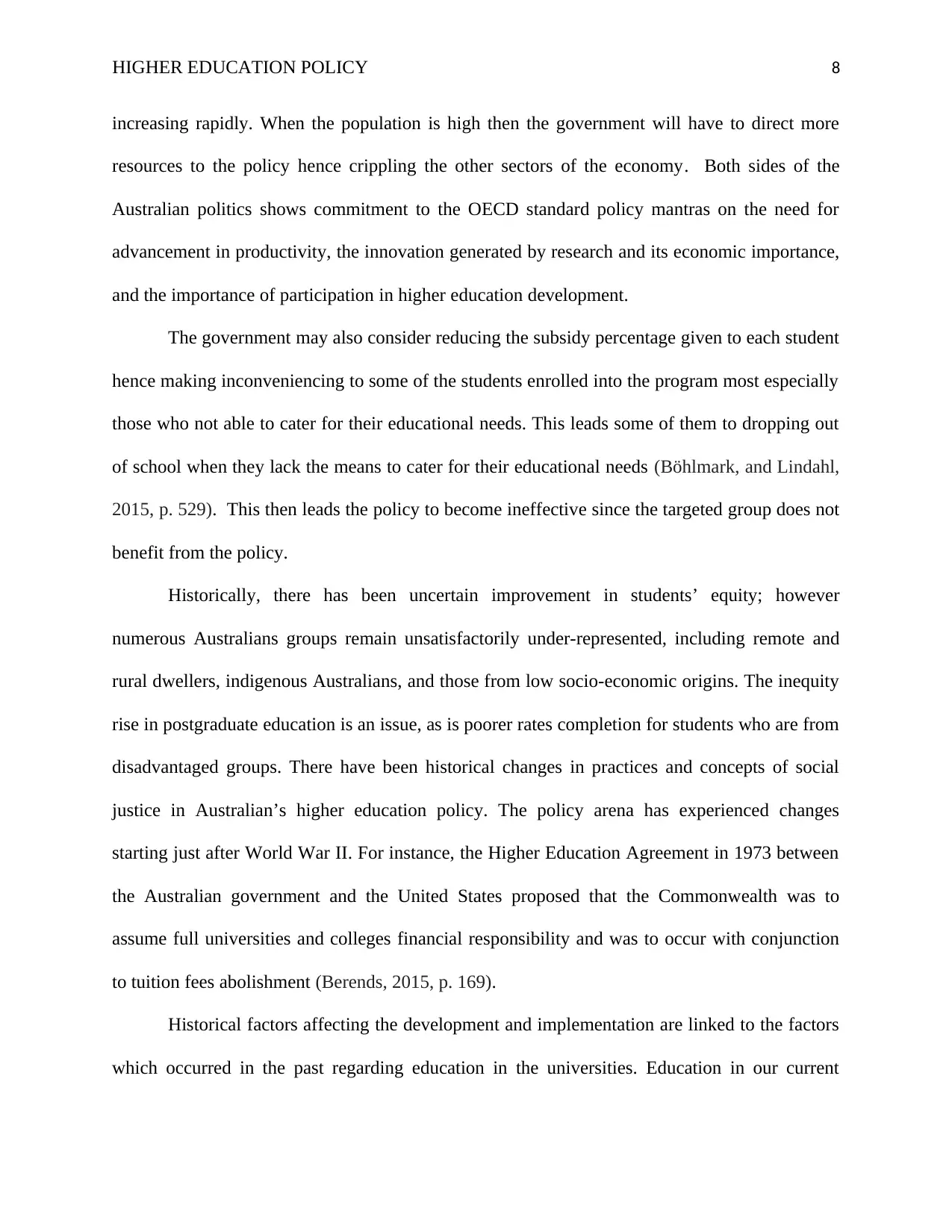
HIGHER EDUCATION POLICY 8
increasing rapidly. When the population is high then the government will have to direct more
resources to the policy hence crippling the other sectors of the economy. Both sides of the
Australian politics shows commitment to the OECD standard policy mantras on the need for
advancement in productivity, the innovation generated by research and its economic importance,
and the importance of participation in higher education development.
The government may also consider reducing the subsidy percentage given to each student
hence making inconveniencing to some of the students enrolled into the program most especially
those who not able to cater for their educational needs. This leads some of them to dropping out
of school when they lack the means to cater for their educational needs (Böhlmark, and Lindahl,
2015, p. 529). This then leads the policy to become ineffective since the targeted group does not
benefit from the policy.
Historically, there has been uncertain improvement in students’ equity; however
numerous Australians groups remain unsatisfactorily under-represented, including remote and
rural dwellers, indigenous Australians, and those from low socio-economic origins. The inequity
rise in postgraduate education is an issue, as is poorer rates completion for students who are from
disadvantaged groups. There have been historical changes in practices and concepts of social
justice in Australian’s higher education policy. The policy arena has experienced changes
starting just after World War II. For instance, the Higher Education Agreement in 1973 between
the Australian government and the United States proposed that the Commonwealth was to
assume full universities and colleges financial responsibility and was to occur with conjunction
to tuition fees abolishment (Berends, 2015, p. 169).
Historical factors affecting the development and implementation are linked to the factors
which occurred in the past regarding education in the universities. Education in our current
increasing rapidly. When the population is high then the government will have to direct more
resources to the policy hence crippling the other sectors of the economy. Both sides of the
Australian politics shows commitment to the OECD standard policy mantras on the need for
advancement in productivity, the innovation generated by research and its economic importance,
and the importance of participation in higher education development.
The government may also consider reducing the subsidy percentage given to each student
hence making inconveniencing to some of the students enrolled into the program most especially
those who not able to cater for their educational needs. This leads some of them to dropping out
of school when they lack the means to cater for their educational needs (Böhlmark, and Lindahl,
2015, p. 529). This then leads the policy to become ineffective since the targeted group does not
benefit from the policy.
Historically, there has been uncertain improvement in students’ equity; however
numerous Australians groups remain unsatisfactorily under-represented, including remote and
rural dwellers, indigenous Australians, and those from low socio-economic origins. The inequity
rise in postgraduate education is an issue, as is poorer rates completion for students who are from
disadvantaged groups. There have been historical changes in practices and concepts of social
justice in Australian’s higher education policy. The policy arena has experienced changes
starting just after World War II. For instance, the Higher Education Agreement in 1973 between
the Australian government and the United States proposed that the Commonwealth was to
assume full universities and colleges financial responsibility and was to occur with conjunction
to tuition fees abolishment (Berends, 2015, p. 169).
Historical factors affecting the development and implementation are linked to the factors
which occurred in the past regarding education in the universities. Education in our current
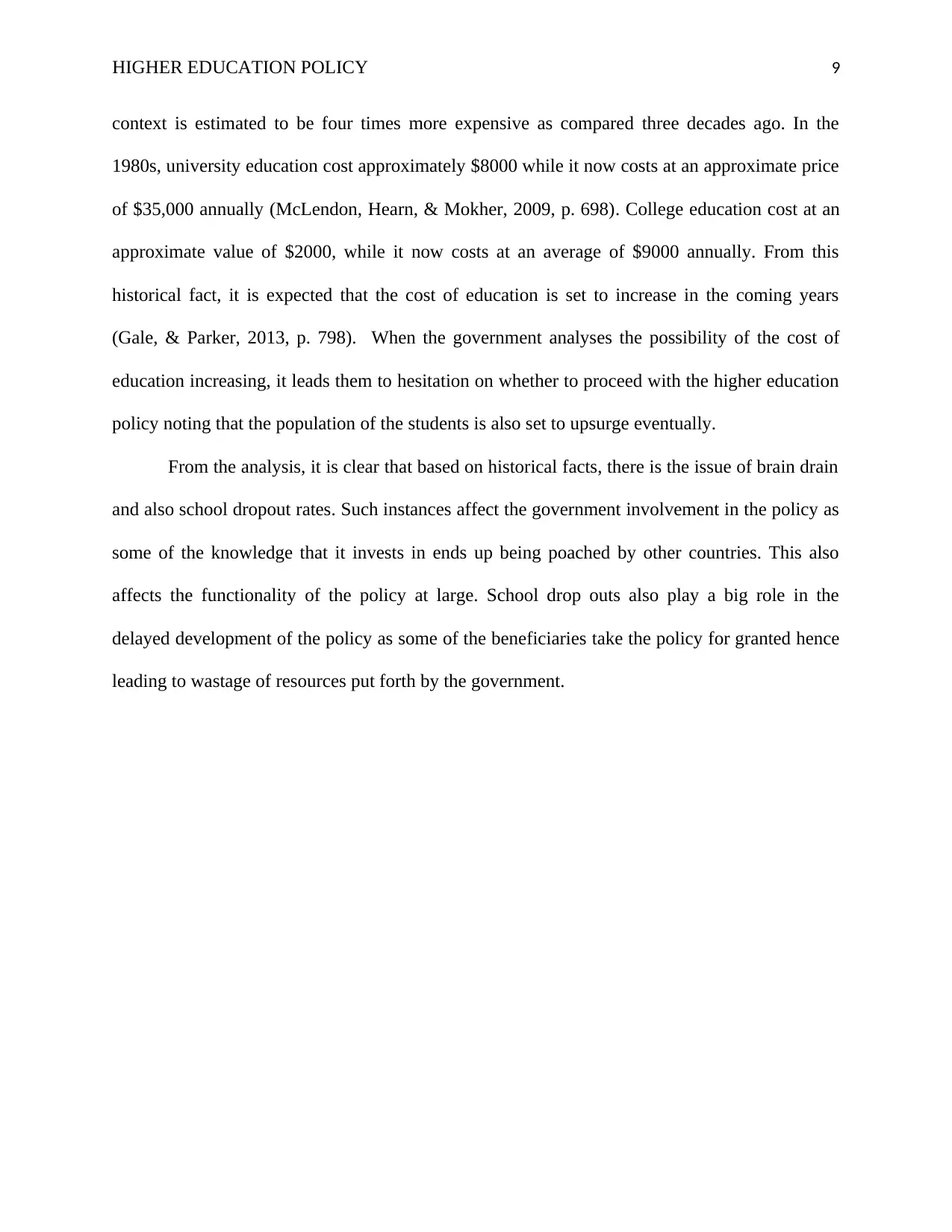
HIGHER EDUCATION POLICY 9
context is estimated to be four times more expensive as compared three decades ago. In the
1980s, university education cost approximately $8000 while it now costs at an approximate price
of $35,000 annually (McLendon, Hearn, & Mokher, 2009, p. 698). College education cost at an
approximate value of $2000, while it now costs at an average of $9000 annually. From this
historical fact, it is expected that the cost of education is set to increase in the coming years
(Gale, & Parker, 2013, p. 798). When the government analyses the possibility of the cost of
education increasing, it leads them to hesitation on whether to proceed with the higher education
policy noting that the population of the students is also set to upsurge eventually.
From the analysis, it is clear that based on historical facts, there is the issue of brain drain
and also school dropout rates. Such instances affect the government involvement in the policy as
some of the knowledge that it invests in ends up being poached by other countries. This also
affects the functionality of the policy at large. School drop outs also play a big role in the
delayed development of the policy as some of the beneficiaries take the policy for granted hence
leading to wastage of resources put forth by the government.
context is estimated to be four times more expensive as compared three decades ago. In the
1980s, university education cost approximately $8000 while it now costs at an approximate price
of $35,000 annually (McLendon, Hearn, & Mokher, 2009, p. 698). College education cost at an
approximate value of $2000, while it now costs at an average of $9000 annually. From this
historical fact, it is expected that the cost of education is set to increase in the coming years
(Gale, & Parker, 2013, p. 798). When the government analyses the possibility of the cost of
education increasing, it leads them to hesitation on whether to proceed with the higher education
policy noting that the population of the students is also set to upsurge eventually.
From the analysis, it is clear that based on historical facts, there is the issue of brain drain
and also school dropout rates. Such instances affect the government involvement in the policy as
some of the knowledge that it invests in ends up being poached by other countries. This also
affects the functionality of the policy at large. School drop outs also play a big role in the
delayed development of the policy as some of the beneficiaries take the policy for granted hence
leading to wastage of resources put forth by the government.
⊘ This is a preview!⊘
Do you want full access?
Subscribe today to unlock all pages.

Trusted by 1+ million students worldwide
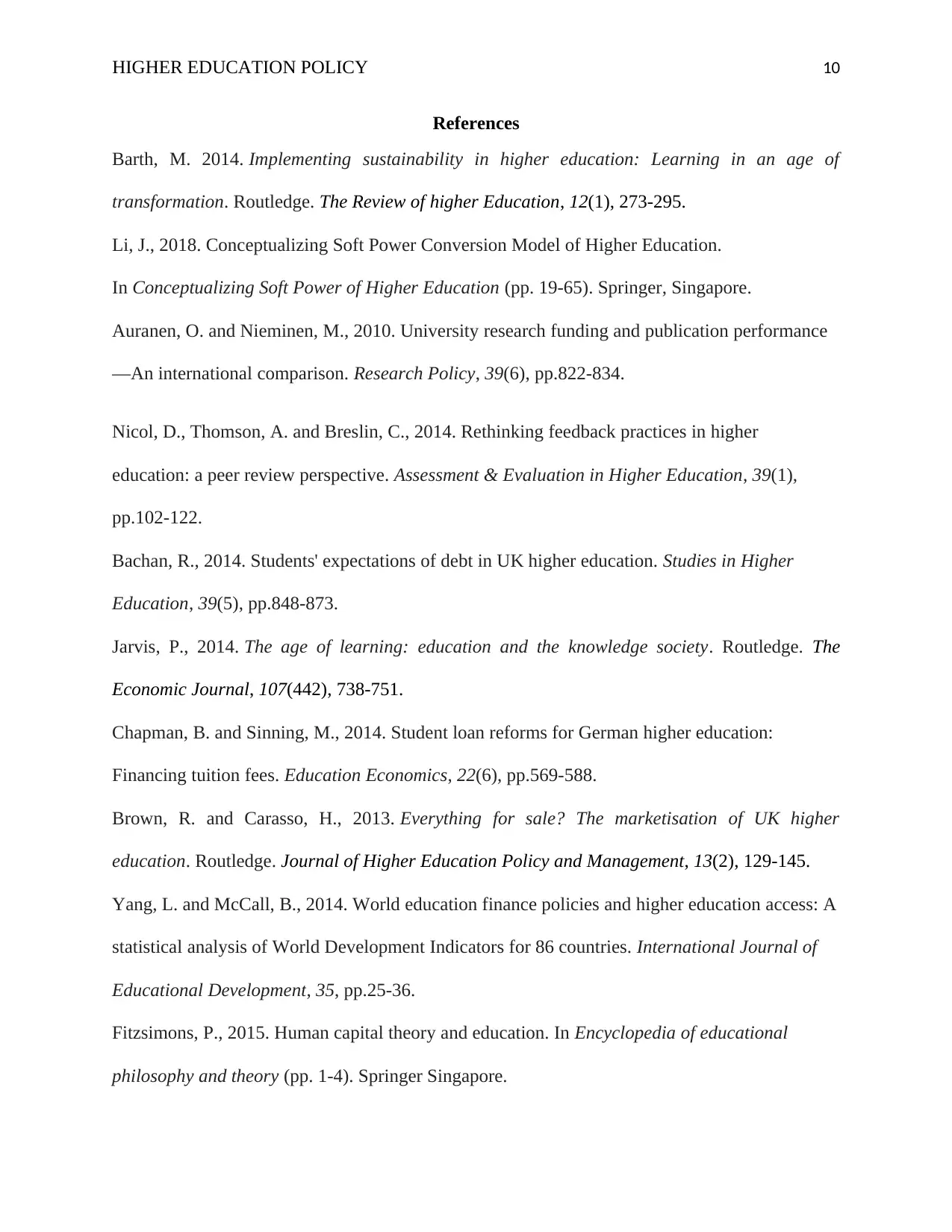
HIGHER EDUCATION POLICY 10
References
Barth, M. 2014. Implementing sustainability in higher education: Learning in an age of
transformation. Routledge. The Review of higher Education, 12(1), 273-295.
Li, J., 2018. Conceptualizing Soft Power Conversion Model of Higher Education.
In Conceptualizing Soft Power of Higher Education (pp. 19-65). Springer, Singapore.
Auranen, O. and Nieminen, M., 2010. University research funding and publication performance
—An international comparison. Research Policy, 39(6), pp.822-834.
Nicol, D., Thomson, A. and Breslin, C., 2014. Rethinking feedback practices in higher
education: a peer review perspective. Assessment & Evaluation in Higher Education, 39(1),
pp.102-122.
Bachan, R., 2014. Students' expectations of debt in UK higher education. Studies in Higher
Education, 39(5), pp.848-873.
Jarvis, P., 2014. The age of learning: education and the knowledge society. Routledge. The
Economic Journal, 107(442), 738-751.
Chapman, B. and Sinning, M., 2014. Student loan reforms for German higher education:
Financing tuition fees. Education Economics, 22(6), pp.569-588.
Brown, R. and Carasso, H., 2013. Everything for sale? The marketisation of UK higher
education. Routledge. Journal of Higher Education Policy and Management, 13(2), 129-145.
Yang, L. and McCall, B., 2014. World education finance policies and higher education access: A
statistical analysis of World Development Indicators for 86 countries. International Journal of
Educational Development, 35, pp.25-36.
Fitzsimons, P., 2015. Human capital theory and education. In Encyclopedia of educational
philosophy and theory (pp. 1-4). Springer Singapore.
References
Barth, M. 2014. Implementing sustainability in higher education: Learning in an age of
transformation. Routledge. The Review of higher Education, 12(1), 273-295.
Li, J., 2018. Conceptualizing Soft Power Conversion Model of Higher Education.
In Conceptualizing Soft Power of Higher Education (pp. 19-65). Springer, Singapore.
Auranen, O. and Nieminen, M., 2010. University research funding and publication performance
—An international comparison. Research Policy, 39(6), pp.822-834.
Nicol, D., Thomson, A. and Breslin, C., 2014. Rethinking feedback practices in higher
education: a peer review perspective. Assessment & Evaluation in Higher Education, 39(1),
pp.102-122.
Bachan, R., 2014. Students' expectations of debt in UK higher education. Studies in Higher
Education, 39(5), pp.848-873.
Jarvis, P., 2014. The age of learning: education and the knowledge society. Routledge. The
Economic Journal, 107(442), 738-751.
Chapman, B. and Sinning, M., 2014. Student loan reforms for German higher education:
Financing tuition fees. Education Economics, 22(6), pp.569-588.
Brown, R. and Carasso, H., 2013. Everything for sale? The marketisation of UK higher
education. Routledge. Journal of Higher Education Policy and Management, 13(2), 129-145.
Yang, L. and McCall, B., 2014. World education finance policies and higher education access: A
statistical analysis of World Development Indicators for 86 countries. International Journal of
Educational Development, 35, pp.25-36.
Fitzsimons, P., 2015. Human capital theory and education. In Encyclopedia of educational
philosophy and theory (pp. 1-4). Springer Singapore.
Paraphrase This Document
Need a fresh take? Get an instant paraphrase of this document with our AI Paraphraser
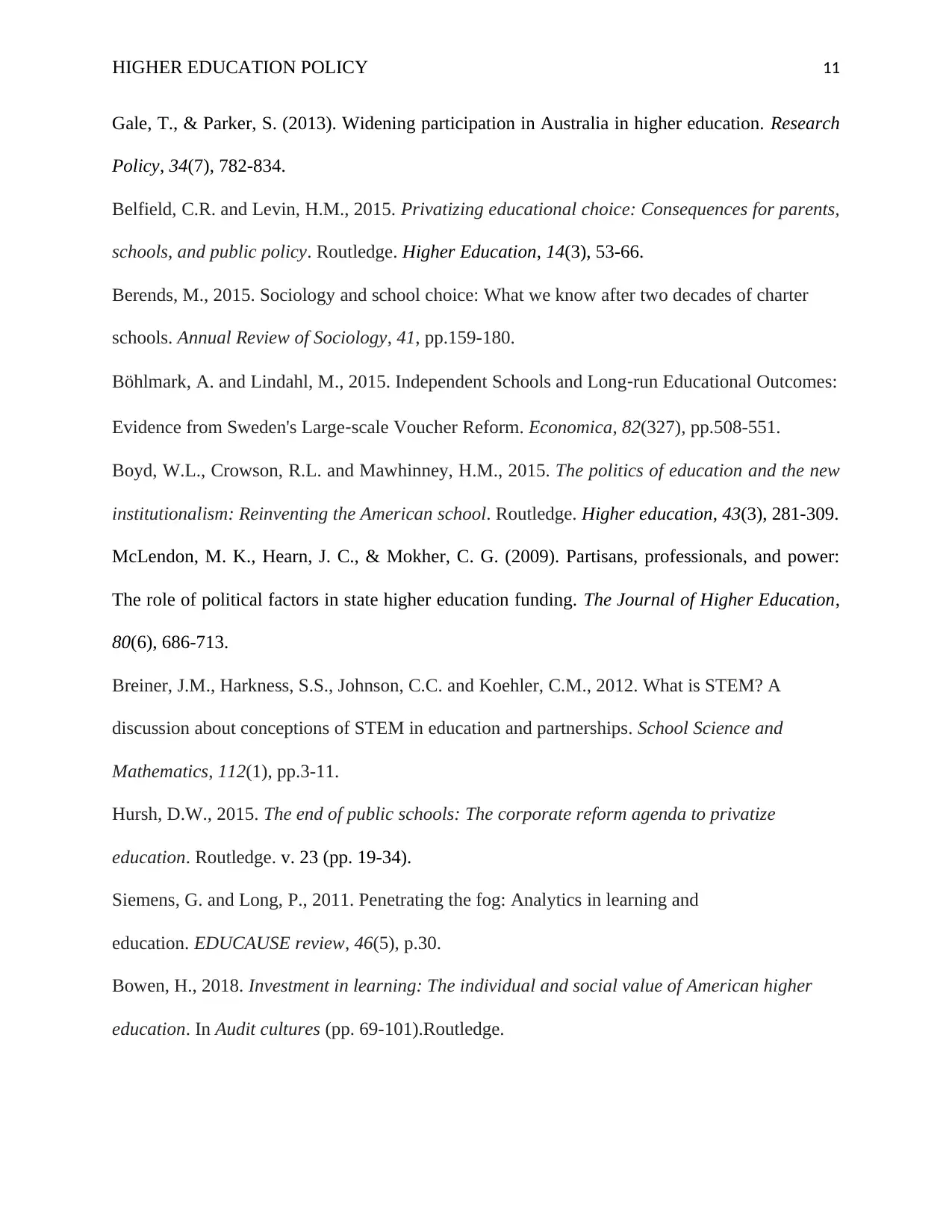
HIGHER EDUCATION POLICY 11
Gale, T., & Parker, S. (2013). Widening participation in Australia in higher education. Research
Policy, 34(7), 782-834.
Belfield, C.R. and Levin, H.M., 2015. Privatizing educational choice: Consequences for parents,
schools, and public policy. Routledge. Higher Education, 14(3), 53-66.
Berends, M., 2015. Sociology and school choice: What we know after two decades of charter
schools. Annual Review of Sociology, 41, pp.159-180.
Böhlmark, A. and Lindahl, M., 2015. Independent Schools and Long‐run Educational Outcomes:
Evidence from Sweden's Large‐scale Voucher Reform. Economica, 82(327), pp.508-551.
Boyd, W.L., Crowson, R.L. and Mawhinney, H.M., 2015. The politics of education and the new
institutionalism: Reinventing the American school. Routledge. Higher education, 43(3), 281-309.
McLendon, M. K., Hearn, J. C., & Mokher, C. G. (2009). Partisans, professionals, and power:
The role of political factors in state higher education funding. The Journal of Higher Education,
80(6), 686-713.
Breiner, J.M., Harkness, S.S., Johnson, C.C. and Koehler, C.M., 2012. What is STEM? A
discussion about conceptions of STEM in education and partnerships. School Science and
Mathematics, 112(1), pp.3-11.
Hursh, D.W., 2015. The end of public schools: The corporate reform agenda to privatize
education. Routledge. v. 23 (pp. 19-34).
Siemens, G. and Long, P., 2011. Penetrating the fog: Analytics in learning and
education. EDUCAUSE review, 46(5), p.30.
Bowen, H., 2018. Investment in learning: The individual and social value of American higher
education. In Audit cultures (pp. 69-101).Routledge.
Gale, T., & Parker, S. (2013). Widening participation in Australia in higher education. Research
Policy, 34(7), 782-834.
Belfield, C.R. and Levin, H.M., 2015. Privatizing educational choice: Consequences for parents,
schools, and public policy. Routledge. Higher Education, 14(3), 53-66.
Berends, M., 2015. Sociology and school choice: What we know after two decades of charter
schools. Annual Review of Sociology, 41, pp.159-180.
Böhlmark, A. and Lindahl, M., 2015. Independent Schools and Long‐run Educational Outcomes:
Evidence from Sweden's Large‐scale Voucher Reform. Economica, 82(327), pp.508-551.
Boyd, W.L., Crowson, R.L. and Mawhinney, H.M., 2015. The politics of education and the new
institutionalism: Reinventing the American school. Routledge. Higher education, 43(3), 281-309.
McLendon, M. K., Hearn, J. C., & Mokher, C. G. (2009). Partisans, professionals, and power:
The role of political factors in state higher education funding. The Journal of Higher Education,
80(6), 686-713.
Breiner, J.M., Harkness, S.S., Johnson, C.C. and Koehler, C.M., 2012. What is STEM? A
discussion about conceptions of STEM in education and partnerships. School Science and
Mathematics, 112(1), pp.3-11.
Hursh, D.W., 2015. The end of public schools: The corporate reform agenda to privatize
education. Routledge. v. 23 (pp. 19-34).
Siemens, G. and Long, P., 2011. Penetrating the fog: Analytics in learning and
education. EDUCAUSE review, 46(5), p.30.
Bowen, H., 2018. Investment in learning: The individual and social value of American higher
education. In Audit cultures (pp. 69-101).Routledge.
1 out of 11
Related Documents
Your All-in-One AI-Powered Toolkit for Academic Success.
+13062052269
info@desklib.com
Available 24*7 on WhatsApp / Email
![[object Object]](/_next/static/media/star-bottom.7253800d.svg)
Unlock your academic potential
Copyright © 2020–2025 A2Z Services. All Rights Reserved. Developed and managed by ZUCOL.


